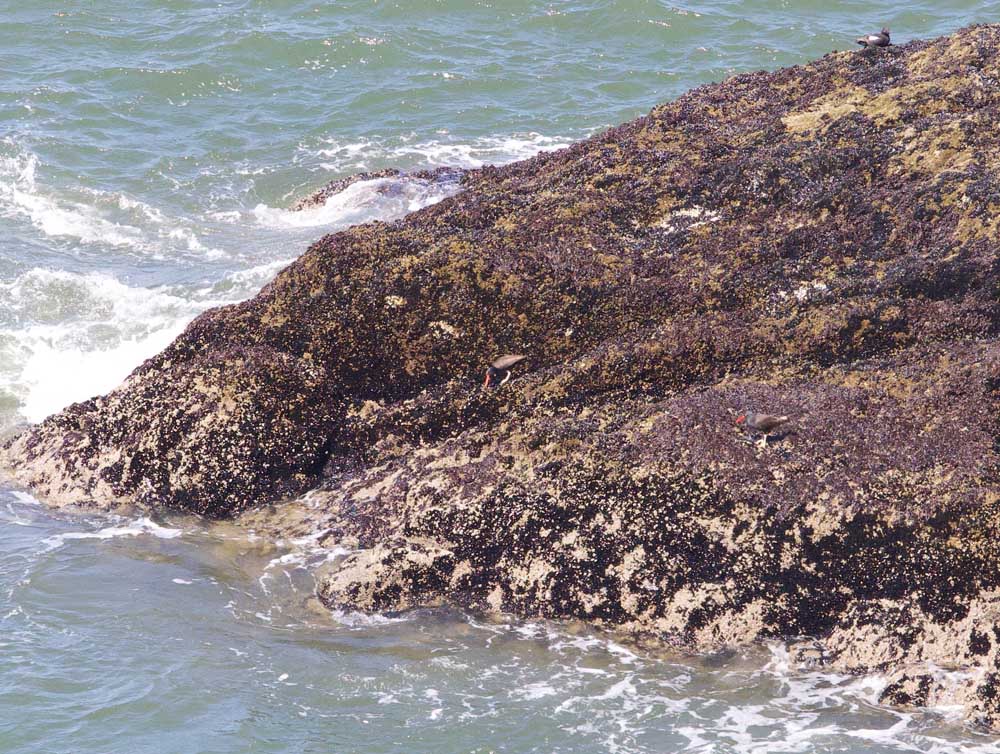Birding: The dawn chorus and summer arrivals
Published 7:34 am Saturday, May 18, 2024

- A pigeon guillemot is resting on the rock in the upper right hand corner of the photo. Can you find the two black oystercatchers with their pinkish legs and dark orange bill? They blend in with the rocks quite well.
Birding has picked up this week. The dawn chorus has become a little louder and more boisterous.
The olive-sided flycatcher came in this week and promptly began to deliver its “hick three beers” or as some say, “quick three beers” from the tops of trees in the yard. It is now one of the lead singers, along with the orange-crowned warbler and the Wilson’s warbler. In the last few days, the spotted towhee began to add its song which sounds like “drink your teeeeeee” and the song sparrow added its loud, penetrating mix of musical whistles and the trills. Both male and female song sparrows added their voices to the chorus. Getting up before the crack of dawn is the best time to hear the melodious beauty of the dawn chorus.
The increase in the songs of the bird choir suggests that more of our summer residents have arrived. So today seemed like a great time to visit my favorite patch, Cape D. It did not disappoint. The first stop was the boat launch area and Maya Lin’s walkway. Bald eagles were everywhere there. Four adults soared high in the sky, while another pair were picking up large beakfuls of what appeared to be eel grass. One carried it to a post where it picked through the debris and flew off with what appeared to be a fish, most likely carrion. Another adult sat high in an evergreen seemingly minding its own business when an American crow spied it and began to harass it. The mobbing continued for at least five minutes. The crow successfully motivated the eagle to move on. Juvenile bald eagles were on parade today in the boat launch area as well. They put on quite a show. Their antics included soaring low and perching low. Photographers loved it.
The walk along the edge of the water to a little sandy beach at the end of the Maya Lin’s path produced an excellent look at a spotted sandpiper as it bobbed its way along the water’s edge looking for something to eat. Great blue herons were foraging in the area as well along with double-crested cormorants. A pair of barn swallows were building a nest under the eaves of the washroom building. Both parents were so intent on building their new digs that they paid no attention to those of us who were watching and taking photos.
The next stop was the interpretive centre. From this vantage point we had a magnificent view of sea birds such as the pigeon guillemot, several surf scoters, and a black scoter. Part of the rock face where three species of cormorants typically nest as indicated by the large whitewash patches on the rocks is also visible from this vantage point. We could also see a pair of black oystercatchers on the rocks. They appeared to be feeding on mollusks. They were quite visible with their pink legs, very long and heavy looking orange bills and all black plumage. Being high, looking down into the sparkling clear waters of the Pacific Ocean made it possible to see the orange legs and large white wing bars of the pigeon guillemots. Two species of cormorant were observed today, the double-crested and the pelagic. A close look with a scope revealed the white plumes of the double crested and what I call the white pantaloons of the pelagic cormorant. A most exciting observation was that of a small flock of four brown pelicans dipsy-doodling with the ocean waves. This seems to be an earlier arrival than usual.
The final stop was Waikiki Beach. From here we could see pelagic cormorants on nests. Mating was happening, so nest building seemed to be complete for most of the pairs.
The other species noted at Cape D were tree swallows, violet-green swallows, white-crowned sparrows, a northern flicker, an American robin, an olive-sided flycatcher and a belted kingfisher. It was a grand day — first the dawn chorus and then the birds of Cape D! Happy birding!








